Abstract
1. The volume of liquid in the lungs of the fetal lamb is reported to fall in the final days of gestation and during labour itself. We aimed to test the hypothesis that this fall in liquid volume adapts the lungs for air breathing and pulmonary gas exchange. 2. In twelve chronically catheterized fetal lambs we measured lung liquid volume at 140 days gestation (term is 147 days) and then delivered the fetuses by Caesarean section under maternal spinal anaesthesia. In five fetuses we removed approximately half the liquid contained in the lungs just before delivery (experimental group) while the remaining seven fetuses were delivered without change to their lung liquid (control group). 3. Lambs born with reduced lung liquid volume improved their arterial blood gas and acid-base status more quickly than lambs born without alteration to lung liquid. 4. Carotid arterial blood gas values in the first 60 min of postnatal life were significantly related to the volume of liquid present in the lungs at birth, with higher arterial partial pressure of oxygen (Pa,02) and arterial oxygen saturation (Sa,02) and lower arterial partial pressure of carbon dioxide (Pa,CO2) levels being associated with lower lung liquid volumes. 5. We conclude that postnatal gas exchange is enhanced by a reduction in the volume of liquid remaining in the lungs when breathing starts.
Full text
PDF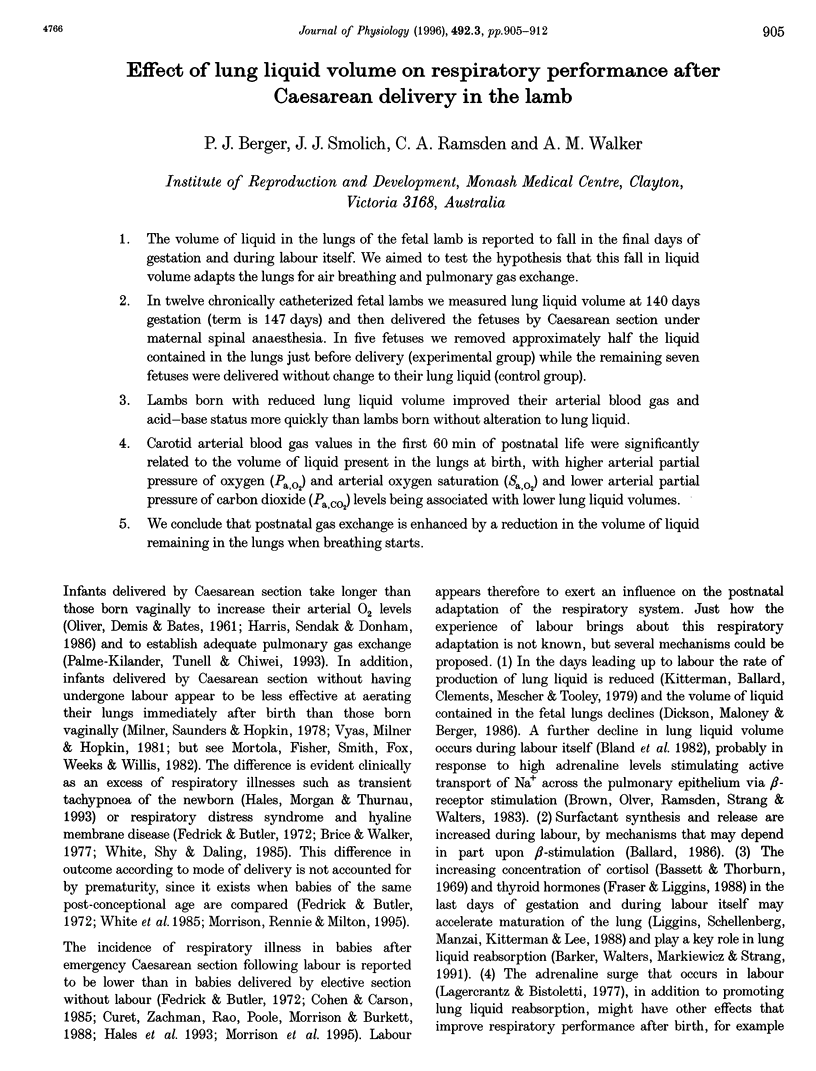
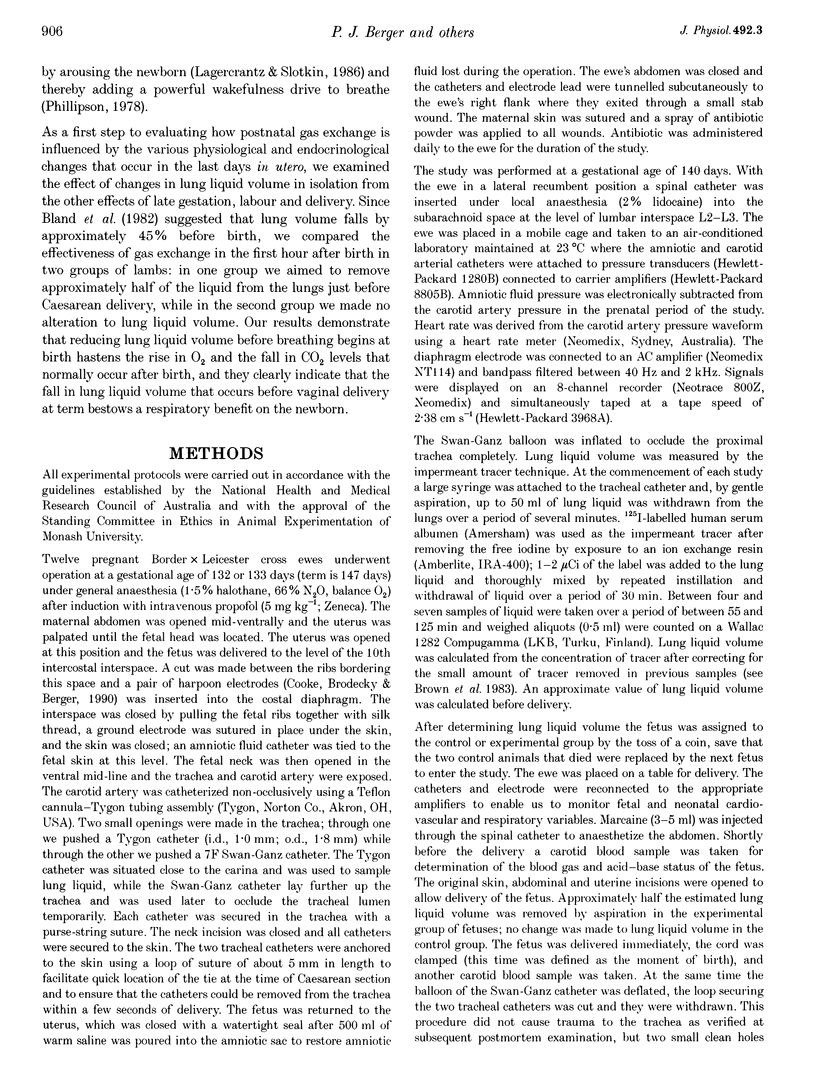
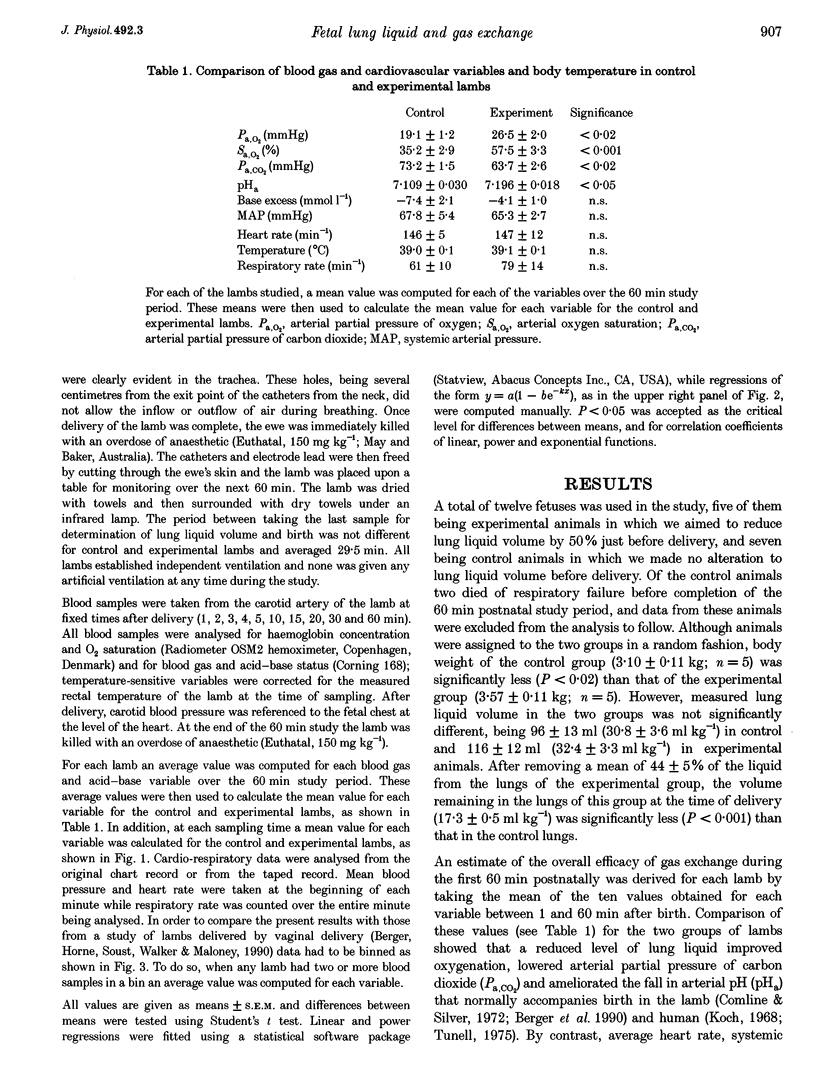
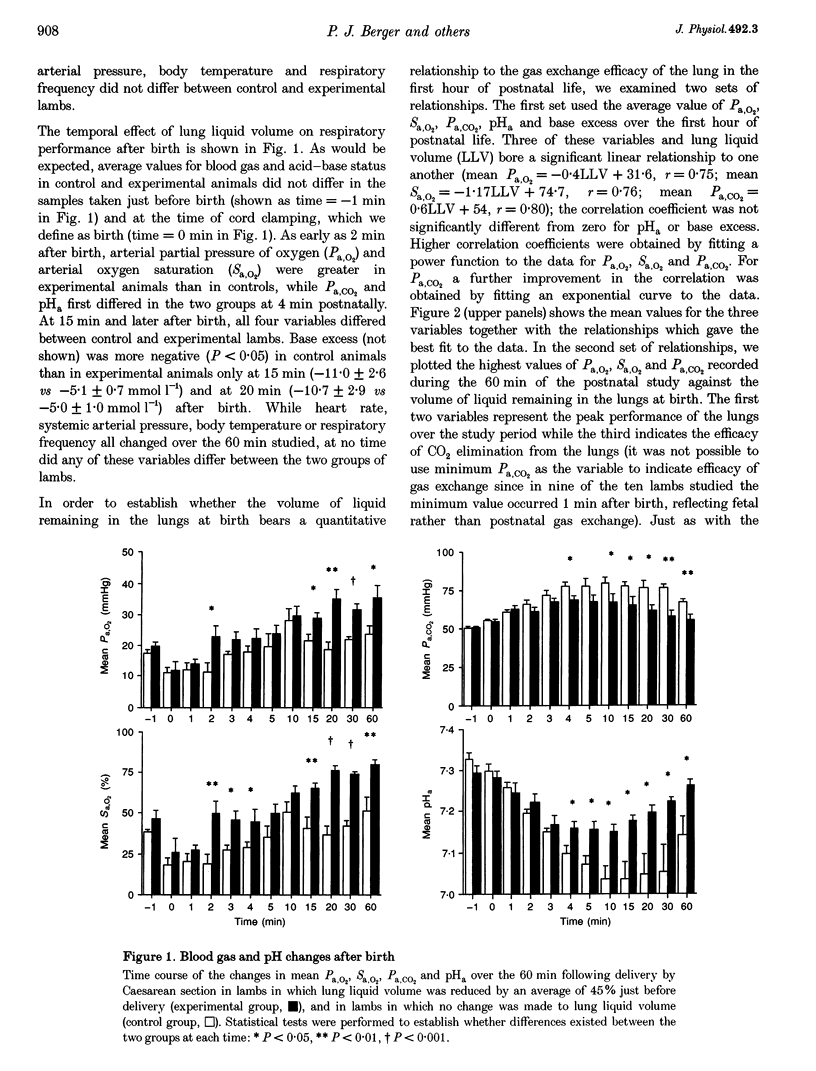
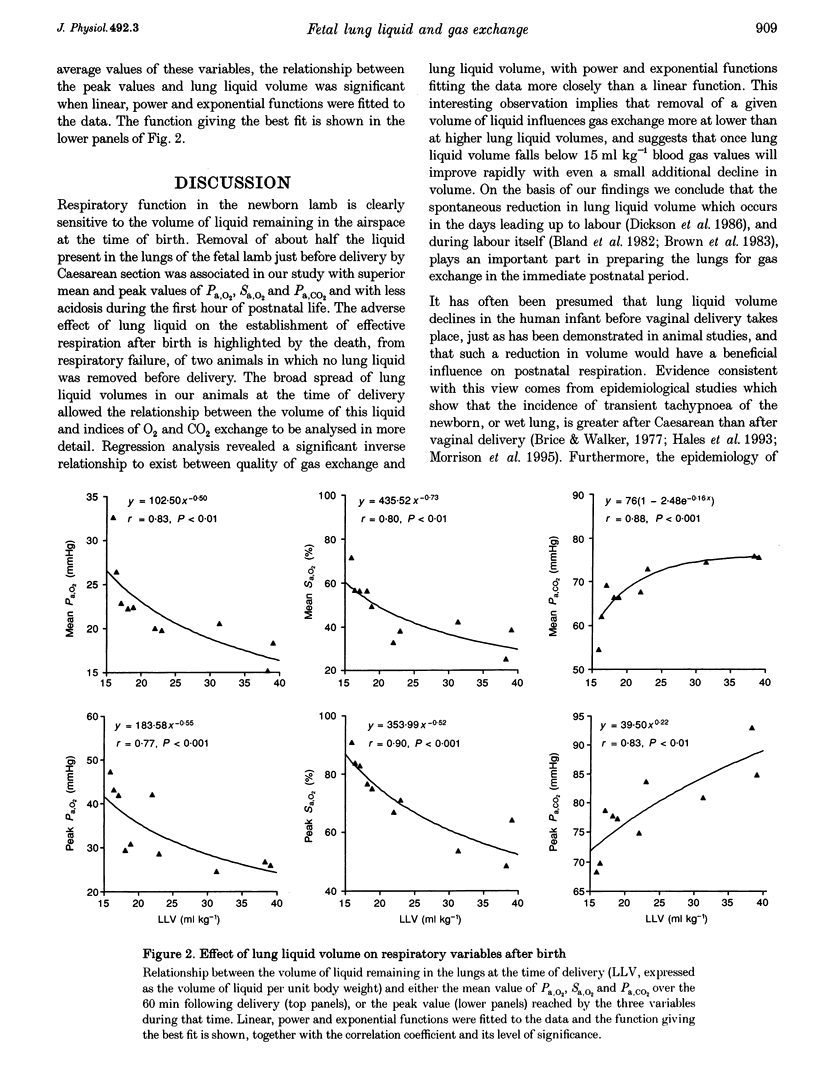
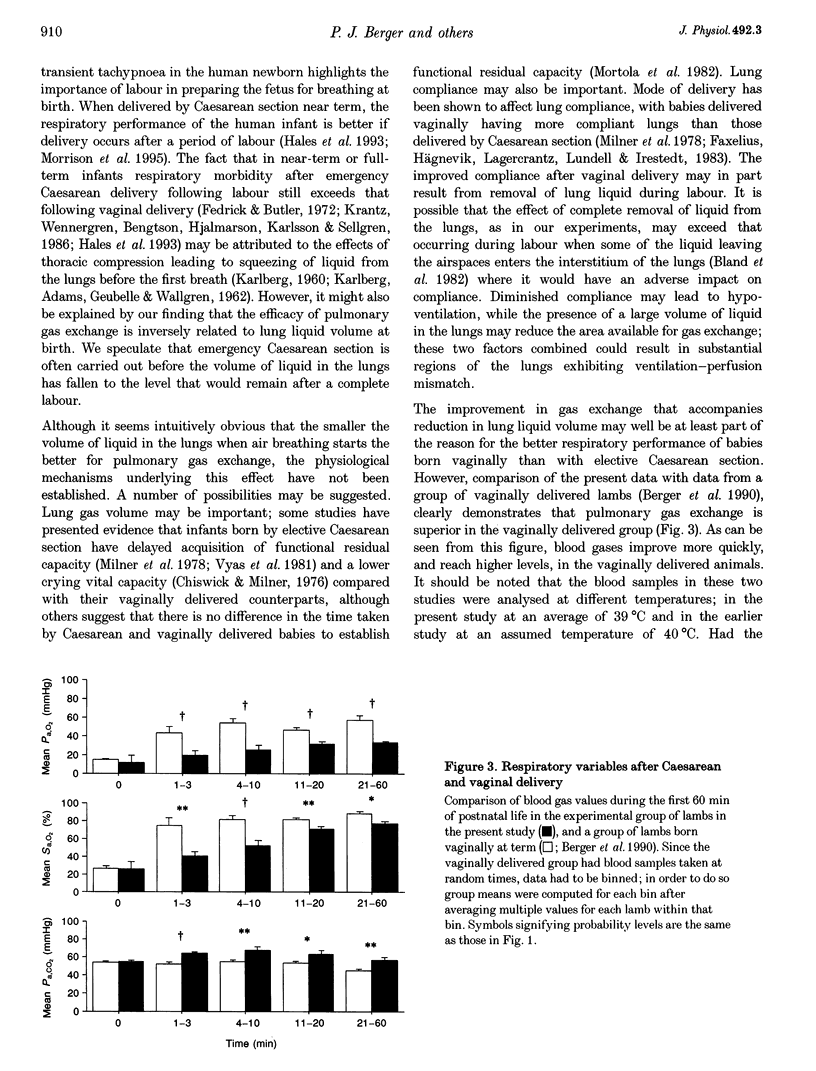
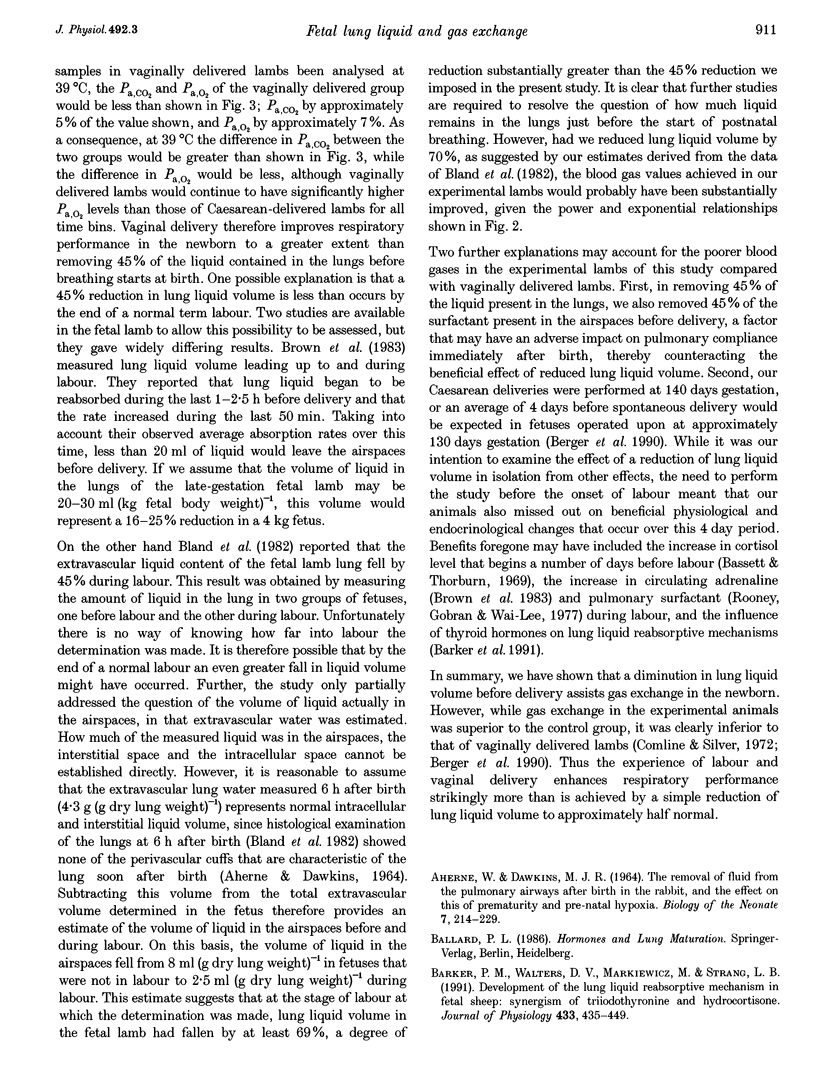
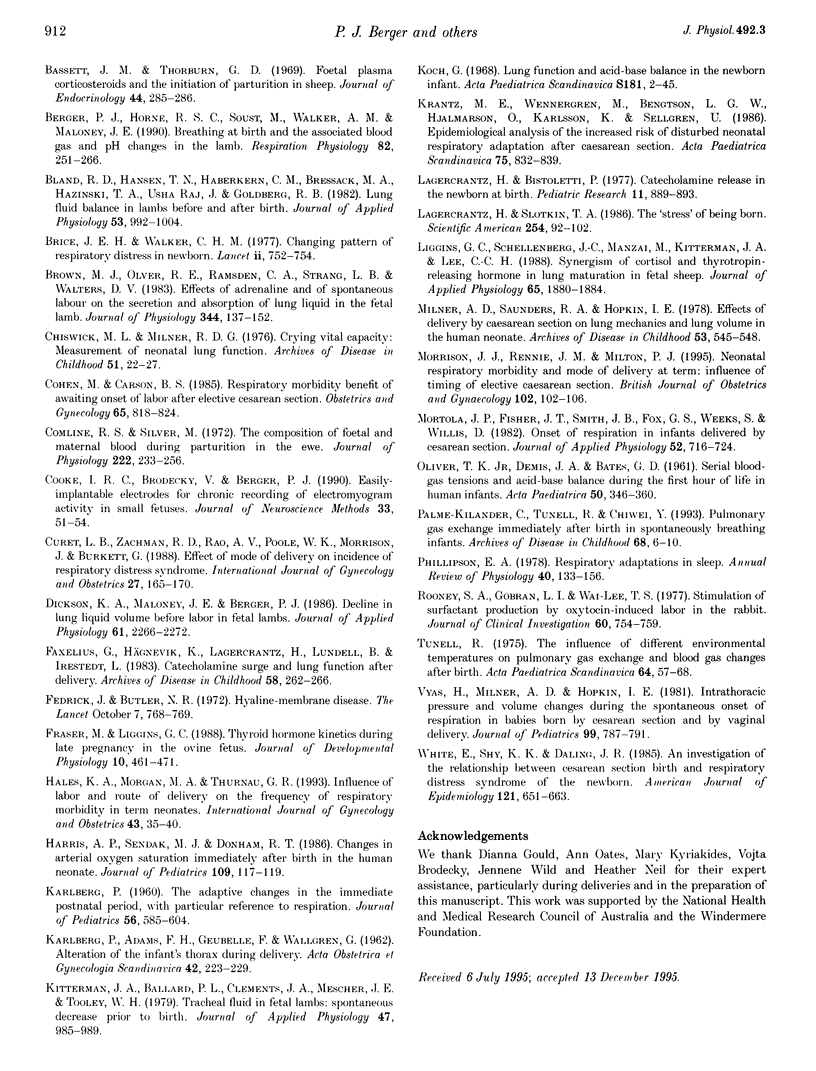
Selected References
These references are in PubMed. This may not be the complete list of references from this article.
- AHERNE W., DAWKINS M. J. THE REMOVAL OF FLUID FROM THE PULMONARY AIRWAYS AFTER BIRTH IN THE RABBIT, AND THE EFFECT ON THIS OF PREMATURITY AND PRE-NATAL HYPOXIA. Biol Neonat. 1964;7:214–229. doi: 10.1159/000239925. [DOI] [PubMed] [Google Scholar]
- Barker P. M., Walters D. V., Markiewicz M., Strang L. B. Development of the lung liquid reabsorptive mechanism in fetal sheep: synergism of triiodothyronine and hydrocortisone. J Physiol. 1991 Feb;433:435–449. doi: 10.1113/jphysiol.1991.sp018436. [DOI] [PMC free article] [PubMed] [Google Scholar]
- Bassett J. M., Thorburn G. D. Foetal plasma corticosteroids and the initiation of parturition in sheep. J Endocrinol. 1969 Jun;44(2):285–286. doi: 10.1677/joe.0.0440285. [DOI] [PubMed] [Google Scholar]
- Berger P. J., Horne R. S., Soust M., Walker A. M., Maloney J. E. Breathing at birth and the associated blood gas and pH changes in the lamb. Respir Physiol. 1990 Nov;82(2):251–265. doi: 10.1016/0034-5687(90)90039-2. [DOI] [PubMed] [Google Scholar]
- Bland R. D., Hansen T. N., Haberkern C. M., Bressack M. A., Hazinski T. A., Raj J. U., Goldberg R. B. Lung fluid balance in lambs before and after birth. J Appl Physiol Respir Environ Exerc Physiol. 1982 Oct;53(4):992–1004. doi: 10.1152/jappl.1982.53.4.992. [DOI] [PubMed] [Google Scholar]
- Brice J. E., Walker C. H. Changing pattern of respiratory distress in newborn. Lancet. 1977 Oct 8;2(8041):752–754. doi: 10.1016/s0140-6736(77)90249-5. [DOI] [PubMed] [Google Scholar]
- Brown M. J., Olver R. E., Ramsden C. A., Strang L. B., Walters D. V. Effects of adrenaline and of spontaneous labour on the secretion and absorption of lung liquid in the fetal lamb. J Physiol. 1983 Nov;344:137–152. doi: 10.1113/jphysiol.1983.sp014929. [DOI] [PMC free article] [PubMed] [Google Scholar]
- Chiswick M. L., Milner R. D. Crying vital capacity. Measurement of neonatal lung function. Arch Dis Child. 1976 Jan;51(1):22–27. doi: 10.1136/adc.51.1.22. [DOI] [PMC free article] [PubMed] [Google Scholar]
- Cohen M., Carson B. S. Respiratory morbidity benefit of awaiting onset of labor after elective cesarean section. Obstet Gynecol. 1985 Jun;65(6):818–824. [PubMed] [Google Scholar]
- Comline R. S., Silver M. The composition of foetal and maternal blood during parturition in the ewe. J Physiol. 1972 Apr;222(1):233–256. doi: 10.1113/jphysiol.1972.sp009795. [DOI] [PMC free article] [PubMed] [Google Scholar]
- Cooke I. R., Brodecky V., Berger P. J. Easily-implantable electrodes for chronic recording of electromyogram activity in small fetuses. J Neurosci Methods. 1990 Jul;33(1):51–54. doi: 10.1016/0165-0270(90)90081-p. [DOI] [PubMed] [Google Scholar]
- Curet L. B., Zachman R. D., Rao A. V., Poole W. K., Morrison J., Burkett G. Effect of mode of delivery on incidence of respiratory distress syndrome. Int J Gynaecol Obstet. 1988 Oct;27(2):165–170. doi: 10.1016/0020-7292(88)90002-1. [DOI] [PubMed] [Google Scholar]
- Dickson K. A., Maloney J. E., Berger P. J. Decline in lung liquid volume before labor in fetal lambs. J Appl Physiol (1985) 1986 Dec;61(6):2266–2272. doi: 10.1152/jappl.1986.61.6.2266. [DOI] [PubMed] [Google Scholar]
- Faxelius G., Hägnevik K., Lagercrantz H., Lundell B., Irestedt L. Catecholamine surge and lung function after delivery. Arch Dis Child. 1983 Apr;58(4):262–266. doi: 10.1136/adc.58.4.262. [DOI] [PMC free article] [PubMed] [Google Scholar]
- Fedrick J., Butler N. R. Hyaline-membrane disease. Lancet. 1972 Oct 7;2(7780):768–769. doi: 10.1016/s0140-6736(72)92067-3. [DOI] [PubMed] [Google Scholar]
- Harris A. P., Sendak M. J., Donham R. T. Changes in arterial oxygen saturation immediately after birth in the human neonate. J Pediatr. 1986 Jul;109(1):117–119. doi: 10.1016/s0022-3476(86)80589-3. [DOI] [PubMed] [Google Scholar]
- KARLBERG P., ADAMS F. H., GEUBELLE F., WALLGREN G. Alteration of the infant's thorax during vaginal delivery. Acta Obstet Gynecol Scand. 1962;41:223–229. doi: 10.3109/00016346209158099. [DOI] [PubMed] [Google Scholar]
- KARLBERG P. The adaptive changes in the immediate postnatal period, with particular reference to respiration. J Pediatr. 1960 May;56:585–604. doi: 10.1016/s0022-3476(60)80332-0. [DOI] [PubMed] [Google Scholar]
- Krantz M. E., Wennergren M., Bengtson L. G., Hjalmarson O., Karlsson K., Sellgren U. Epidemiological analysis of the increased risk of disturbed neonatal respiratory adaptation after caesarean section. Acta Paediatr Scand. 1986 Sep;75(5):832–839. doi: 10.1111/j.1651-2227.1986.tb10298.x. [DOI] [PubMed] [Google Scholar]
- Lagercrantz H., Bistoletti P. Catecholamine release in the newborn infant at birth. Pediatr Res. 1977 Aug;11(8):889–893. doi: 10.1203/00006450-197708000-00007. [DOI] [PubMed] [Google Scholar]
- Liggins G. C., Schellenberg J. C., Manzai M., Kitterman J. A., Lee C. C. Synergism of cortisol and thyrotropin-releasing hormone in lung maturation in fetal sheep. J Appl Physiol (1985) 1988 Oct;65(4):1880–1884. doi: 10.1152/jappl.1988.65.4.1880. [DOI] [PubMed] [Google Scholar]
- Milner A. D., Saunders R. A., Hopkin I. E. Effects of delivery by caesarean section on lung mechanics and lung volume in the human neonate. Arch Dis Child. 1978 Jul;53(7):545–548. doi: 10.1136/adc.53.7.545. [DOI] [PMC free article] [PubMed] [Google Scholar]
- Morrison J. J., Rennie J. M., Milton P. J. Neonatal respiratory morbidity and mode of delivery at term: influence of timing of elective caesarean section. Br J Obstet Gynaecol. 1995 Feb;102(2):101–106. doi: 10.1111/j.1471-0528.1995.tb09060.x. [DOI] [PubMed] [Google Scholar]
- Mortola J. P., Fisher J. T., Smith J. B., Fox G. S., Weeks S., Willis D. Onset of respiration in infants delivered by cesarean section. J Appl Physiol Respir Environ Exerc Physiol. 1982 Mar;52(3):716–724. doi: 10.1152/jappl.1982.52.3.716. [DOI] [PubMed] [Google Scholar]
- OLIVER T. K., Jr, DEMIS J. A., BATES G. D. Serial blood-gas tensions and acid-base balance during the first hour of life in human infants. Acta Paediatr. 1961 Jul;50:346–360. doi: 10.1111/j.1651-2227.1961.tb08185.x. [DOI] [PubMed] [Google Scholar]
- Palme-Kilander C., Tunell R., Chiwei Y. Pulmonary gas exchange immediately after birth in spontaneously breathing infants. Arch Dis Child. 1993 Jan;68(1 Spec No):6–10. doi: 10.1136/adc.68.1_spec_no.6. [DOI] [PMC free article] [PubMed] [Google Scholar]
- Phillipson E. A. Respiratory adaptations in sleep. Annu Rev Physiol. 1978;40:133–156. doi: 10.1146/annurev.ph.40.030178.001025. [DOI] [PubMed] [Google Scholar]
- Rooney S. A., Gobran L. I., Wai-Lee T. S. Stimulation of surfactant production by oxytocin-induced labor in the rabbit. J Clin Invest. 1977 Sep;60(3):754–759. doi: 10.1172/JCI108828. [DOI] [PMC free article] [PubMed] [Google Scholar]
- Tunell R. The influence of different environmental temperatures on pulmonary gas exchange and blood gas changes after birth. Acta Paediatr Scand. 1975 Jan;64(1):57–68. doi: 10.1111/j.1651-2227.1975.tb04380.x. [DOI] [PubMed] [Google Scholar]
- Vyas H., Milner A. D., Hopkins I. E. Intrathoracic pressure and volume changes during the spontaneous onset of respiration in babies born by cesarean section and by vaginal delivery. J Pediatr. 1981 Nov;99(5):787–791. doi: 10.1016/s0022-3476(81)80412-x. [DOI] [PubMed] [Google Scholar]


